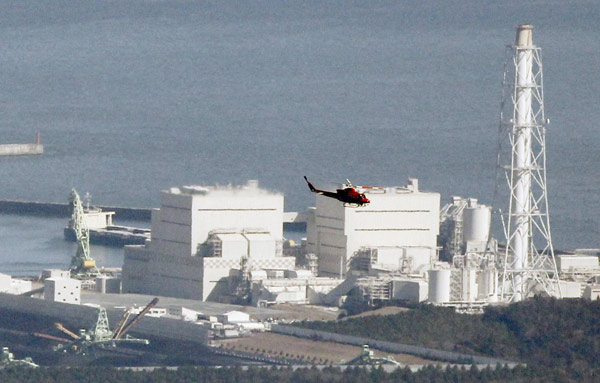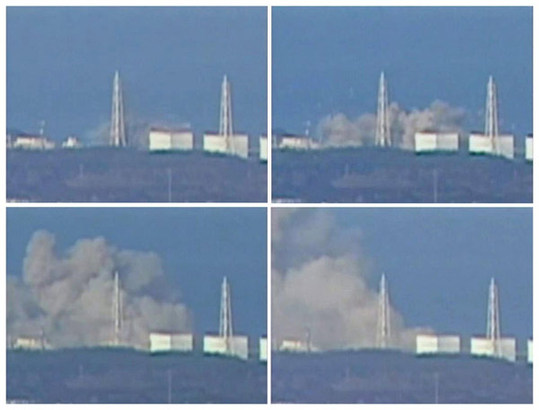Asia
Radiation leaks from Japan's nuclear plant
Updated: 2011-03-12 16:34
(Agencies)
|
 A helicopter flies past Japan's Fukushima Daiichi No 1 Nuclear reactor March 12, 2011. [Photo/Agencies]
|
TOKYO - Radiation leaked from Japan's earthquake-crippled nuclear plant on Saturday after a blast blew the roof off, and authorities prepared to distribute iodine to people in the vicinity to protect them from exposure.
The government insisted radiation levels were low because although the explosion severely damaged the main building of the plant, it had not affected the reactor core container.
Local media said three workers suffered radiation exposure at the plant in the wake of Friday's massive earthquake, which sent a 10-metre (33-foot) tsunami ripping through towns and cities across the northeast coast.
Kyodo news agency said more than 1,700 people were killed or missing as a result of the 8.9-magnitude earthquake, the biggest in Japan since records began in the nineteenth century.
Later it said 9,500 people in one town were unreachable, but gave no other details.
The blast raised fears of a meltdown at the power facility, 240 km (150 miles) north of Tokyo, as officials scrambled to contain what could be the worst nuclear disaster since the Chernobyl explosion in 1986 that shocked the world.
However, experts said Japan should not expect a repeat of Chernobyl. They said pictures of mist above the plant suggested only small amounts of radiation had been expelled as part of measures to ensure its stability, far from the radioactive clouds Chernobyl spewed out 25 years ago.
Valeriy Hlyhalo, deputy director of the Chernobyl nuclear safety centre, was quoted by Interfax news agency as saying Japanese reactors were better protected than Chernobyl.
"Apart from that, these reactors are designed to work at a high seismicity zone, although what has happened is beyond the impact the plants were designed to withstand," Hlyhalo said. Japan's Chief Cabinet Secretary Yukio Edano told reporters the nuclear reaction facility was surrounded by a steel storage machine, which was itself surrounded by a concrete building.
"This concrete building collapsed. We learnt that the storage machine inside did not explode," he said.
Edano initially said an evacuation radius of 10 km (6 miles) from the stricken 40-year-old Daiichi 1 reactor plant in Fukushima prefecture was adequate, but then an hour later the boundary was extended to 20 km (13 miles). TV footage showed vapour rising from the plant.
Japanese officials told the U.N.'s atomic watchdog they were making preparations to distribute iodine to people living near nuclear power plants affected by the quake, the Vienna-based agency said. Iodine can be used to help protect the body from radioactive exposure.
The wind at the disabled plant was blowing from the south, which could affect residents north of the facility, Japan's national weather forecaster said, adding the direction may shift later so that it blows from the north-west towards the sea.
The direction of the wind is a key factor in judging possible damage on the environment from radiation.
DAZED PEOPLE HOARD WATER
Along the northeast coast, rescue workers searched through the rubble of destroyed buildings, cars and boats, looking for survivors in hardest-hit areas such as the city of Sendai, 300 km (180 miles) northeast of Tokyo.
Dazed residents hoarded water and huddled in makeshift shelters in near-freezing temperatures. Aerial footage showed buildings and trains strewn over mudflats like children's toys.
"All the shops are closed, this is one of the few still open. I came to buy and stock up on diapers, drinking water and food," Kunio Iwatsuki, 68, told Reuters in Mito city, where residents queued outside a damaged supermarket for supplies.
Across the coastline, survivors clambered over nearly impassable roads. In Iwanuma, not far from Sendai, people spelled S.O.S. out on the roof of a hospital surrounded by water, one of many desperate scenes.
The earthquake and tsunami, and now the radiation leak, present Japan's government with its biggest challenge in a generation.
The blast at the nuclear facility came as plant operator Tokyo Electric Power Co (TEPCO) was working desperately to reduce pressures in the core of the reactor.
The company has had a rocky past in an industry plagued by scandal. In 2002, the president of the country's largest power utility was forced to resign along with four other senior executives, taking responsibility for suspected falsification of nuclear plant safety records.
Earlier the operator released what it said was a tiny amount of radioactive steam to reduce the pressure and the danger was minimal because tens of thousands of people had already been evacuated from the vicinity.
Reuters journalists were in Fukushima prefecture, about 70 km (40 miles) from the plant. Other media reported police roadblocks in the area to prevent people getting closer.
 |
|
This combination photo shows smoke rising from Fukushima Daiichi 1 nuclear |
INTERNATIONAL RELIEF EFFORT
Friday's tremor was so huge that thousands fled their homes from coastlines around the Pacific Rim, as far away as North and South America, fearful of a tsunami.
Most appeared to have been spared anything more serious than some high waves, unlike Japan's northeast coastline which was hammered by the huge tsunami that turned houses and ships into floating debris as it surged into cities and villages, sweeping aside everything in its path.
"I thought I was going to die," said Wataru Fujimura, a 38-year-old sales representative in Koriyama, Fukushima, north of Tokyo and close to the area worst hit by the quake.
"Our furniture and shelves had all fallen over and there were cracks in the apartment building, so we spent the whole night in the car ... Now we're back home trying to clean."
In one of the worst-hit residential areas, people buried under rubble could be heard calling out for rescue, Kyodo news agency reported earlier.
The international community started to send disaster relief teams on Saturday to help Japan, with the United Nations sending a group to help coordinate work.
The disaster struck as the world's third-largest economy had been showing signs of reviving from an economic contraction in the final quarter of last year. It raised the prospect of major disruptions for many key businesses and a massive repair bill running into tens of billions of dollars.
Italy's National Institute of Geophysics and Volcanology said the earth's axis shifted 25 cm as a result of the earthquake, and the U.S. Geological Survey said the main island of Japan had shifted 2.4 metres.
The earthquake was the fifth most powerful to hit the world in the past century. It surpassed the Great Kant quake of Sept. 1, 1923, which had a magnitude of 7.9 and killed more than 140,000 people in the Tokyo area.
Specials

Earthquake Hits Japan
A massive 8.8 magnitude quake hit the northeast coast of Japan on March 11,2011.

NPC & CPPCC sessions
Lawmakers and political advisers gather in Beijing to discuss major issues.

Pictures: quake aftermath
A massive earthquake hit Japan hard, leaving thousands dead.